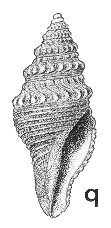
Revised descriptions of New Zealand Cenozoic Mollusca from Beu and Maxwell (1990)

 | Revised descriptions of New Zealand Cenozoic Mollusca from Beu and Maxwell (1990) | 
|
  (Pl. 42q): GS10849, V20/f8572, Devil's Elbow mudstone, top of north face of Devil's Elbow hill, Napier-Wairoa highway, Nukumaruan (GNS) |
Beu & Maxwell (1990): Chapter 15; p. 326; pl. 42 q.
Synonymy: Pleurotoma tuberculata Kirk 1882, p. 409 (not of Gray, 1839); Pleurotoma (Hemipleurotoma) nodilirata Murdoch & Suter 1906, p. 284 (not of E. A. Smith, 1878; new name for P. tuberculata Kirk, preoccupied); Bathytoma murdochi Finlay 1930a, p. 46 (new name for P. nodilirata Murdoch & Suter, preoccupied); ?Micantapex finlayi Powell 1940, p. 245; Micantapex murdochi; Bathytoma (Micantapex) murdochi murdochi, Beu & Maxwell 1990, p. 326, pl. 42q.
Classification: Conidae: "Clathurellinae" clade 20 (Puillabdre et al. 2008)
Description: Moderate-sized for genus (23-27 mm high), relatively short and wide, biconic, with moderately tall spire and moderately long, open, lightly curved canal with low fasciole. Low, finely nodulous subsutural fold and prominent, wide, rounded, coarsely nodulous peripheral keel are the most obvious sculpture; sutural ramp deeply concave, smooth except for growth lines; below periphery, many highly variable, narrow spiral cords have 1 or few intermediate threads in some forms. Anal sinus wide, V-shaped, with apex at peripheral nodulous keel. Aperture long, oval, with thin, smooth lips. Protoconch relatively large, dome-shaped, of 1.5 smooth whorls.
Comparison: Now that Bathytoma (Bathytoma) finlayi (Clifden, Southland, Altonian-Clifdenian) and B. (Micantapex) finlayi (Recent) are placed in the same genus, the latter is clearly a secondary homonym of the former. However, the modern population is much more variable than Powell (1942, p. 56) thought when he distinguished M. finlayi from M. murdochi "by having fewer peripheral nodules, only 13-16 per whorl, and narrower basal spirals, the upper ones being much wider spaced" (M. murdochi was said to have 20-22 nodules per whorl). Comparison of collections showed no apparently consistent differences between B. murdochi and the Recent form named B. finlayi (not of Laws), and it appears unlikely that a new name is necessary for the Recent form. The taxonomy of the genus in New Zealand is greatly in need of revision, but one point that can be adopted immediately is to cease recognising a "subgenus" Micantapex based on protoconch type (i.e., develpmental history) alone, as there is no doubt that many species of Bathytoma have lost planktotrophy independently from distinct ancestors, and Micantapex is not a useful clade.
Distribution: Mangapanian(?)- Nukumaruan (-Recent?). "Tertiary beds near Petane, Hawke's Bay", i.e., hillside north of Petane Pa, north of mouth of Esk River, north of Napier, Nukumaruan (type of Pleurotoma tuberculata, renamed Pleurotoma nodilirata by Murdoch & Suter (1906) (preoccupied), renamed Bathytoma murdochi by Finlay (1930a)); Recent, off Great Barrier Island, north-eastern New Zealand (type of M. finlayi). Typical, relatively finely sculptured specimens of B. murdochi are common in blue-grey siltstone throughout central and southern Hawke's Bay (Nukumaruan), but many similar forms have been named in Opoitian to Recent faunas from throughout New Zealand, and it is unclear how many are valid species; forms named from southern Wairarapa Mangapanian-Nukumaruan rocks (B. paucispiralis; B. murdochi prior) have more prominent basal cords but seem to intergrade with "typical" Hawke's Bay Nukumaruan specimens of B. murdochi.
Cite this publication as: "A.G. Beu and J.I. Raine (2009). Revised
descriptions of New Zealand Cenozoic Mollusca from Beu and Maxwell (1990). GNS
Science miscellaneous series no. 27."
© GNS Science, 2009
ISBN
978-0-478-19705-1
ISSN 1177-2441
(Included with a PDF facsimile file
copy of New Zealand Geological Survey Paleontological Bulletin 58 in CD version
from: Publications Officer, GNS Science, P.O. Box 30368 Lower Hutt, New
Zealand)